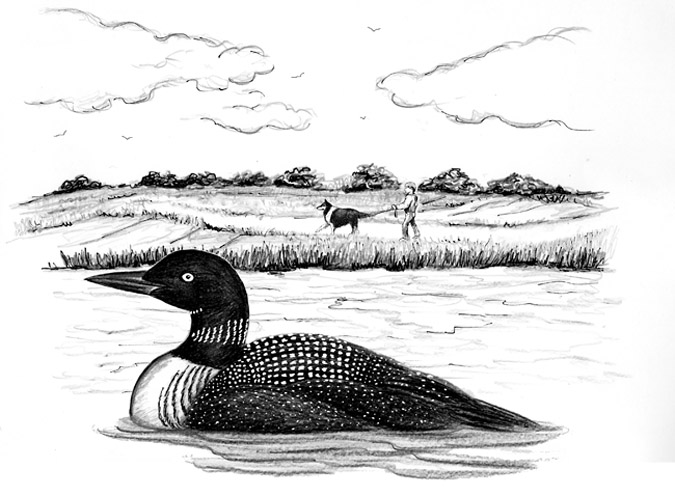
Dear Bird Folks,
I often walk around Mill Pond in Orleans. It’s a good place to look for ducks and other water birds. (Although I avoid the summer when the trail is crowded with dog walkers). Last spring I regularly saw a single loon swimming in the pond. Now that it’s fall and I’m back to my routine, I noticed that the same lone loon is still there. Do you think there is something wrong with it? Why is it all alone?
–Adam, Orleans, MA
I know what you mean, Adam,
I live near Mill Pond and most of the year it is a good place to look for water birds. But like you said, in July and August Mill Pond becomes the summer home of the American Kennel Club. Folks aren’t even allowed to walk in that area unless they have at least one dog, and preferably three. But the dogs aren’t the problem; it’s their chatty owners. For some reason they feel the need to stop in the middle of the path and introduce their passing dogs to each other…as if the dogs cared. Walker number one will say, “This is, Tobey.” Walker two will respond (in a high, squeaky voice), “Hello Tobey. Are you a good boy? This is Romeo.” (A dog named Romeo. Can you imagine?) It goes on from there. And while the dogs are having a sniff-fest, their owners are secretly looking to see which dog has the best leash and the prettiest collar, while they try to avoid making eye contact with the hanging poop bag. I’m sure a lot of dog owners are growling at me right now, but they know it’s all true.
Even though Common Loons are a symbol of secluded northern lakes and rustic camps, just about everyone is familiar with them. Even folks who have never seen a wild loon, certainly have seen its striking image on the endless posters, mugs and T-shirts found in north country shops. In addition, we’ve all heard the loon’s unique voice, even if we didn’t know it. Clueless Hollywood producers love to use the loon’s chilling call as a background sound, regardless of whether the scene takes place in actual loon habitat or not. (And as far as I know, the birds never get paid…not even scale.)
What a lot of people don’t realize is that Cape Cod is a great place to see these stately birds. Lakes are where loons breed, but when they aren’t breeding, they live in saltwater, which is something Cape Cod has plenty of. A few weeks ago I wrote about Ospreys and how the adults migrated early, leaving their kids behind to sort things out on their own. Common Loons also subscribe to this same parenting method. The north woods are not a lot of fun in the winter and the adults know it, so they head south once they have finished their parenting chores. Meantime, the oblivious kids remain behind to work on their fishing skills and enjoy the fall foliage. But eventually the lakes freeze and the young loons finally figure out why mom and dad left so early.
Eventually, most loons reach the coast where they settle in for the winter. When spring arrives the steps are reversed and the adults return to the lakes, but not the newbies. Again, like the Ospreys, for the first few years of their lives, loons remain on the “wintering” grounds year-round. Believe it or not, loons don’t breed until they are six years old. That’s surprising. (Aren’t there a few states where humans don’t even wait that long?) Since these loons won’t be doing any breeding, they don’t even bother heading north. Instead, they stay here and enjoy the summer sun, saltwater and dogs along with the rest of us.
I think I may know the exact loon you are talking about, Adam. I, too, watched it all spring and like you I lost contact with it after Memorial Day. I had assumed it had gone north with the other loons, but three nights ago I heard it calling. I immediately put down my well-worn copy of Bridget Jones’s Diary and ran outside to listen. Hearing the loon put a smile on my face. Of course, anytime I hear a loon it puts a smile on my face, but I was pleased to know that last spring’s loon was still around (at least, I think it was last spring’s loon). For the next few nights the bird continued to yodel. One night it was so loud that the neighborhood coyotes joined in. Wow! What a thrill. I stood out on the deck and just listened. I couldn’t believe that in my crowded, overly manicured neighborhood, I was being treated to a duet of two of nature’s most haunting sounds. Again, wow!
Most water birds enjoy each other’s company, so they tend to travel in flocks, but loons are more like Greta Garbo…they want to be alone. Thus, it’s perfectly normal to see one all by itself. The bird we are both seeing, Adam, is most likely a sub-adult. It is simply hanging out on Cape Cod and chillaxing, looking forward to the day when it will be old enough to mate for the first time (and I think we all can remember what that was like).
Anyone who wants to see loons should start looking because they are headed this way. As I said earlier, Common Loons migrate to the coast in the fall. Pretty soon there will be lots of them scattered throughout the waters of Cape Cod. Just don’t expect them to look like the pretty loons we see on posters, mugs and T-shirts. In the winter loons lose their distinctive plumage and become rather gray and ordinary. But there is nothing wrong with being gray and ordinary. I’ve been getting by like that for years.